Deck 2: Functions and Graphs
Question
Question
Question
Question
Question
Question
Question
Question
Question
Question
Question
Question
Question
Question
Question
Question
Question
Question
Question
Question
Question
Question
Question
Question
Question
Question
Question
Question
Question
Question
Question
Question
Question
Question
Question
Question
Question
Question
Question
Question
Question
Question
Question
Question
Question
Question
Question
Question
Question
Question
Question
Question
Question
Question
Question
Question
Question
Question
Question
Question
Question
Question
Question
Question
Question
Question
Question
Question
Question
Question
Question
Question
Question
Question
Question
Question
Question
Question
Question
Question

Unlock Deck
Sign up to unlock the cards in this deck!
Unlock Deck
Unlock Deck
1/144
Play
Full screen (f)
Deck 2: Functions and Graphs
1
Determine whether the relation is a function.
{(-8, -9), (-8, 9), (1, 3), (3, 5), (10, -9)}
A)Not a function
B)Function
{(-8, -9), (-8, 9), (1, 3), (3, 5), (10, -9)}
A)Not a function
B)Function
A
2
Give the domain and range of the relation.
{(10, -3), (12, 3), (-8, -7), (6, -1)}
A)domain = {6, 10, -8, 12}; range = {-1, -1, -3, -7, 3}
B)domain = {-1, -3, -7, 3}; range = {6, 10, -8, 12}
C)domain = {6, 10, -8, 12}; range = {-1, 3, -3, -7, 3}
D)domain = {6, 10, -8, 12}; range = {-1, -3, -7, 3}
{(10, -3), (12, 3), (-8, -7), (6, -1)}
A)domain = {6, 10, -8, 12}; range = {-1, -1, -3, -7, 3}
B)domain = {-1, -3, -7, 3}; range = {6, 10, -8, 12}
C)domain = {6, 10, -8, 12}; range = {-1, 3, -3, -7, 3}
D)domain = {6, 10, -8, 12}; range = {-1, -3, -7, 3}
D
3
Determine whether the equation defines y as a function of x.
x + y = 36
A)y is a function of x
B)y is not a function of x
x + y = 36
A)y is a function of x
B)y is not a function of x
A
4
Give the domain and range of the relation.
{(-6, -2), (10, -6), (9, -5), (9, 8)}
A)domain = {10, 9, -6, -9}; range = {-6, -5, -2, 8}
B)domain = {-6, -5, -2, 8}; range = {10, 9, -6}
C)domain = {10, 9, -6}; range = {-6, -5, -2, 8}
D)domain = {10, 9, -6, 19}; range = {-6, -5, -2, 8}
{(-6, -2), (10, -6), (9, -5), (9, 8)}
A)domain = {10, 9, -6, -9}; range = {-6, -5, -2, 8}
B)domain = {-6, -5, -2, 8}; range = {10, 9, -6}
C)domain = {10, 9, -6}; range = {-6, -5, -2, 8}
D)domain = {10, 9, -6, 19}; range = {-6, -5, -2, 8}

Unlock Deck
Unlock for access to all 144 flashcards in this deck.
Unlock Deck
k this deck
5
Determine whether the relation is a function.
{(-7, 2), (-3, -3), (1, 8), (2, 3)}
A)Not a function
B)Function
{(-7, 2), (-3, -3), (1, 8), (2, 3)}
A)Not a function
B)Function

Unlock Deck
Unlock for access to all 144 flashcards in this deck.
Unlock Deck
k this deck
6
Give the domain and range of the relation.
{(-2, 3), (-1, 0), (0, -1), (1, 0), (3, 8)}
A)domain: {-2, -1, 1, 3}; range: {3, 0, -1, 8}
B)domain: {3, 0, -1, 8}; range: {-2, -1, 0, 1, 3}
C)domain: {3, 0, -1, 8}; range: {-2, -1, 1, 3}
D)domain: {-2, -1, 0, 1, 3}; range: {3, 0, -1, 8}
{(-2, 3), (-1, 0), (0, -1), (1, 0), (3, 8)}
A)domain: {-2, -1, 1, 3}; range: {3, 0, -1, 8}
B)domain: {3, 0, -1, 8}; range: {-2, -1, 0, 1, 3}
C)domain: {3, 0, -1, 8}; range: {-2, -1, 1, 3}
D)domain: {-2, -1, 0, 1, 3}; range: {3, 0, -1, 8}

Unlock Deck
Unlock for access to all 144 flashcards in this deck.
Unlock Deck
k this deck
7
Determine whether the relation is a function.
{(-6, -5), (-3, -7), (4, 6), (4, 8)}
A)Not a function
B)Function
{(-6, -5), (-3, -7), (4, 6), (4, 8)}
A)Not a function
B)Function

Unlock Deck
Unlock for access to all 144 flashcards in this deck.
Unlock Deck
k this deck
8
Determine whether the relation is a function.
{(-6, 1), (-3, -6), (4, -6), (4, -3)}
A)Function
B)Not a function
{(-6, 1), (-3, -6), (4, -6), (4, -3)}
A)Function
B)Not a function

Unlock Deck
Unlock for access to all 144 flashcards in this deck.
Unlock Deck
k this deck
9
Give the domain and range of the relation.
{(-6, 5), (-6, -7), (5, -6), (6, -1), (-4, -5)}
A)domain = {5, -4, 6, -6}; range = {-6, -5, -1, -7, 5}
B)domain = {5, 13, -4, 6, -6}; range = {-6, -5, -1, -7, 5}
C)domain = {-6, -5, -1, -7, 5}; range = {5, 5, -4, 6, -6}
D)domain = {5, -3, -4, 6, -6}; range = {-6, -5, -1, -7, 5}
{(-6, 5), (-6, -7), (5, -6), (6, -1), (-4, -5)}
A)domain = {5, -4, 6, -6}; range = {-6, -5, -1, -7, 5}
B)domain = {5, 13, -4, 6, -6}; range = {-6, -5, -1, -7, 5}
C)domain = {-6, -5, -1, -7, 5}; range = {5, 5, -4, 6, -6}
D)domain = {5, -3, -4, 6, -6}; range = {-6, -5, -1, -7, 5}

Unlock Deck
Unlock for access to all 144 flashcards in this deck.
Unlock Deck
k this deck
10
Determine whether the relation is a function.
{(-4, -4), (-2, 1), (-1, -7), (5, -9)}
A)Function
B)Not a function
{(-4, -4), (-2, 1), (-1, -7), (5, -9)}
A)Function
B)Not a function

Unlock Deck
Unlock for access to all 144 flashcards in this deck.
Unlock Deck
k this deck
11
Give the domain and range of the relation.
{(-6, -3), (-8, -1), (-4, -7), (8, 2), (5, -4)}
A)domain = {2, -7, -3, -1, -4}; range = {8, -4, -6, -8, 5}
B)domain = {8, 2, -4, -7, -6}; range = {-3, -8, -1, 5, -4}
C)domain = {-3, -8, -1, 5, -4}; range = {8, 2, -4, -7, -6}
D)domain = {8, -4, -6, -8, 5}; range = {2, -7, -3, -1, -4}
{(-6, -3), (-8, -1), (-4, -7), (8, 2), (5, -4)}
A)domain = {2, -7, -3, -1, -4}; range = {8, -4, -6, -8, 5}
B)domain = {8, 2, -4, -7, -6}; range = {-3, -8, -1, 5, -4}
C)domain = {-3, -8, -1, 5, -4}; range = {8, 2, -4, -7, -6}
D)domain = {8, -4, -6, -8, 5}; range = {2, -7, -3, -1, -4}

Unlock Deck
Unlock for access to all 144 flashcards in this deck.
Unlock Deck
k this deck
12
Determine whether the relation is a function.
{(-6, 9), (-3, 6), (2, 2), (8, 4)}
A)Not a function
B)Function
{(-6, 9), (-3, 6), (2, 2), (8, 4)}
A)Not a function
B)Function

Unlock Deck
Unlock for access to all 144 flashcards in this deck.
Unlock Deck
k this deck
13
Give the domain and range of the relation.
{(6, 7), (10, -8), (9, 6), (9, 2)}
A)domain = {9, 6, 10}; range = {6, 7, -8, 2}
B)domain = {9, 6, 10, -9}; range = {6, 7, -8, 2}
C)domain = {9, 6, 10, 19}; range = {6, 7, -8, 2}
D)domain = {6, 7, -8, 2}; range = {9, 6, 10}
{(6, 7), (10, -8), (9, 6), (9, 2)}
A)domain = {9, 6, 10}; range = {6, 7, -8, 2}
B)domain = {9, 6, 10, -9}; range = {6, 7, -8, 2}
C)domain = {9, 6, 10, 19}; range = {6, 7, -8, 2}
D)domain = {6, 7, -8, 2}; range = {9, 6, 10}

Unlock Deck
Unlock for access to all 144 flashcards in this deck.
Unlock Deck
k this deck
14
Determine whether the relation is a function.
{(1, 5), (2, 3), (5, -3), (7, -3), (11, 7)}
A)Function
B)Not a function
{(1, 5), (2, 3), (5, -3), (7, -3), (11, 7)}
A)Function
B)Not a function

Unlock Deck
Unlock for access to all 144 flashcards in this deck.
Unlock Deck
k this deck
15
Determine whether the relation is a function.
{(-7, -8), (-7, -5), (2, 2), (4, -8), (10, 6)}
A)Function
B)Not a function
{(-7, -8), (-7, -5), (2, 2), (4, -8), (10, 6)}
A)Function
B)Not a function

Unlock Deck
Unlock for access to all 144 flashcards in this deck.
Unlock Deck
k this deck
16
Give the domain and range of the relation.
{(5, -4), (1, -3), (1, 0), (10, 3), (26, 5)}
A)domain: {-4, -3, 0, 3, 5}; range: {5, 10, 1, 26}
B)domain: {5, 10, 1, 26}; range: {-4, -3, 3, 5}
C)domain: {-4, -3, 3, 5}; range: {5, 10, 1, 26}
D)domain: {5, 10, 1, 26}; range: {-4, -3, 0, 3, 5}
{(5, -4), (1, -3), (1, 0), (10, 3), (26, 5)}
A)domain: {-4, -3, 0, 3, 5}; range: {5, 10, 1, 26}
B)domain: {5, 10, 1, 26}; range: {-4, -3, 3, 5}
C)domain: {-4, -3, 3, 5}; range: {5, 10, 1, 26}
D)domain: {5, 10, 1, 26}; range: {-4, -3, 0, 3, 5}

Unlock Deck
Unlock for access to all 144 flashcards in this deck.
Unlock Deck
k this deck
17
Determine whether the equation defines y as a function of x.



Unlock Deck
Unlock for access to all 144 flashcards in this deck.
Unlock Deck
k this deck
18
Determine whether the equation defines y as a function of x.



Unlock Deck
Unlock for access to all 144 flashcards in this deck.
Unlock Deck
k this deck
19
Determine whether the relation is a function.
{(3, -9), (3, 3), (4, 9), (7, 4), (10, 7)}
A)Not a function
B)Function
{(3, -9), (3, 3), (4, 9), (7, 4), (10, 7)}
A)Not a function
B)Function

Unlock Deck
Unlock for access to all 144 flashcards in this deck.
Unlock Deck
k this deck
20
Determine whether the relation is a function.
{(-2, -9), (3, -5), (6, 6), (8, 1), (11, 2)}
A)Function
B)Not a function
{(-2, -9), (3, -5), (6, 6), (8, 1), (11, 2)}
A)Function
B)Not a function

Unlock Deck
Unlock for access to all 144 flashcards in this deck.
Unlock Deck
k this deck
21
Determine whether the equation defines y as a function of x.



Unlock Deck
Unlock for access to all 144 flashcards in this deck.
Unlock Deck
k this deck
22
Evaluate the function at the given value of the independent variable and simplify.



Unlock Deck
Unlock for access to all 144 flashcards in this deck.
Unlock Deck
k this deck
23
Determine whether the equation defines y as a function of x.



Unlock Deck
Unlock for access to all 144 flashcards in this deck.
Unlock Deck
k this deck
24
Determine whether the equation defines y as a function of x.



Unlock Deck
Unlock for access to all 144 flashcards in this deck.
Unlock Deck
k this deck
25
Evaluate the function at the given value of the independent variable and simplify.



Unlock Deck
Unlock for access to all 144 flashcards in this deck.
Unlock Deck
k this deck
26
Evaluate the function at the given value of the independent variable and simplify.



Unlock Deck
Unlock for access to all 144 flashcards in this deck.
Unlock Deck
k this deck
27
Evaluate the function at the given value of the independent variable and simplify.



Unlock Deck
Unlock for access to all 144 flashcards in this deck.
Unlock Deck
k this deck
28
The total cost in dollars for a certain company to produce x empty jars to be used by a jelly producer is given by the function C(x)= 0.8x + 40,000. Find C(50,000), the cost of producing 50,000 jars.
A)$40.80
B)$80,000
C)$40,000
D)$50,040
A)$40.80
B)$80,000
C)$40,000
D)$50,040

Unlock Deck
Unlock for access to all 144 flashcards in this deck.
Unlock Deck
k this deck
29
Evaluate the function at the given value of the independent variable and simplify.



Unlock Deck
Unlock for access to all 144 flashcards in this deck.
Unlock Deck
k this deck
30
Evaluate the function at the given value of the independent variable and simplify.



Unlock Deck
Unlock for access to all 144 flashcards in this deck.
Unlock Deck
k this deck
31
Evaluate the function at the given value of the independent variable and simplify.



Unlock Deck
Unlock for access to all 144 flashcards in this deck.
Unlock Deck
k this deck
32
Determine whether the equation defines y as a function of x.



Unlock Deck
Unlock for access to all 144 flashcards in this deck.
Unlock Deck
k this deck
33
Determine whether the equation defines y as a function of x.



Unlock Deck
Unlock for access to all 144 flashcards in this deck.
Unlock Deck
k this deck
34
Evaluate the function at the given value of the independent variable and simplify.



Unlock Deck
Unlock for access to all 144 flashcards in this deck.
Unlock Deck
k this deck
35
Determine whether the equation defines y as a function of x.



Unlock Deck
Unlock for access to all 144 flashcards in this deck.
Unlock Deck
k this deck
36
Determine whether the equation defines y as a function of x.



Unlock Deck
Unlock for access to all 144 flashcards in this deck.
Unlock Deck
k this deck
37
Evaluate the function at the given value of the independent variable and simplify.



Unlock Deck
Unlock for access to all 144 flashcards in this deck.
Unlock Deck
k this deck
38
Determine whether the equation defines y as a function of x.



Unlock Deck
Unlock for access to all 144 flashcards in this deck.
Unlock Deck
k this deck
39
Determine whether the equation defines y as a function of x.



Unlock Deck
Unlock for access to all 144 flashcards in this deck.
Unlock Deck
k this deck
40
Determine whether the equation defines y as a function of x.



Unlock Deck
Unlock for access to all 144 flashcards in this deck.
Unlock Deck
k this deck
41
Graph the given functions on the same rectangular coordinate system. Describe how the graph of g is related to the graph
of f.
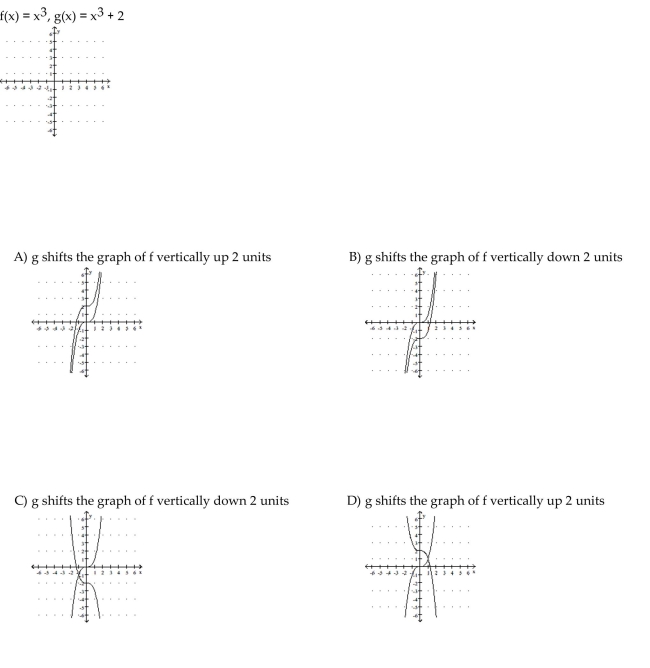
of f.


Unlock Deck
Unlock for access to all 144 flashcards in this deck.
Unlock Deck
k this deck
42
Graph the given functions on the same rectangular coordinate system. Describe how the graph of g is related to the graph
of f.
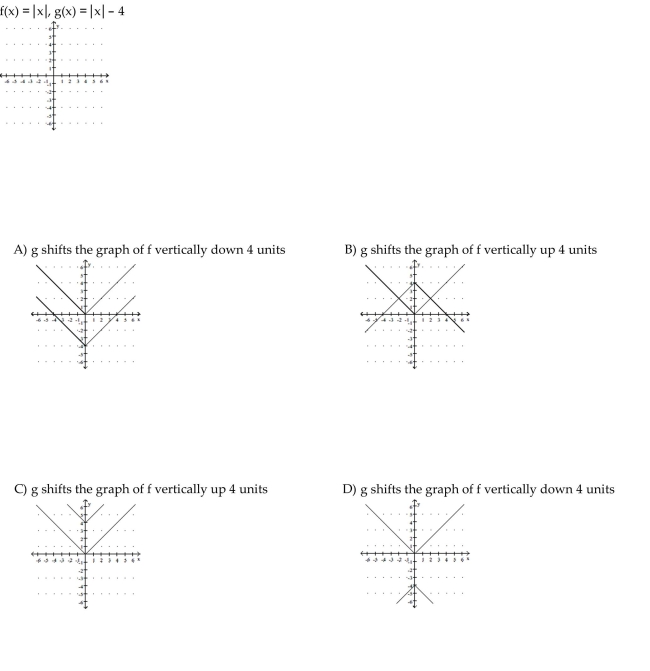
of f.


Unlock Deck
Unlock for access to all 144 flashcards in this deck.
Unlock Deck
k this deck
43
Use the vertical line test to determine whether or not the graph is a graph in which y is a function of x.
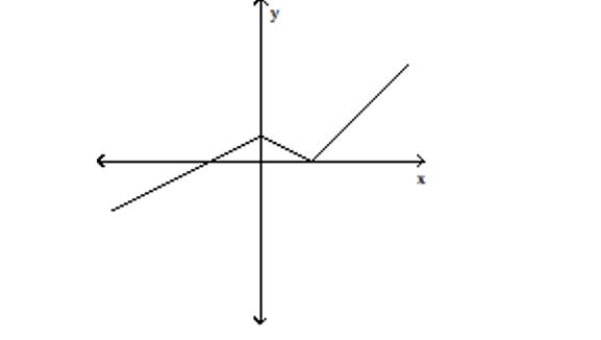
A)function
B)not a function

A)function
B)not a function

Unlock Deck
Unlock for access to all 144 flashcards in this deck.
Unlock Deck
k this deck
44
Graph the given functions on the same rectangular coordinate system. Describe how the graph of g is related to the graph
of f.
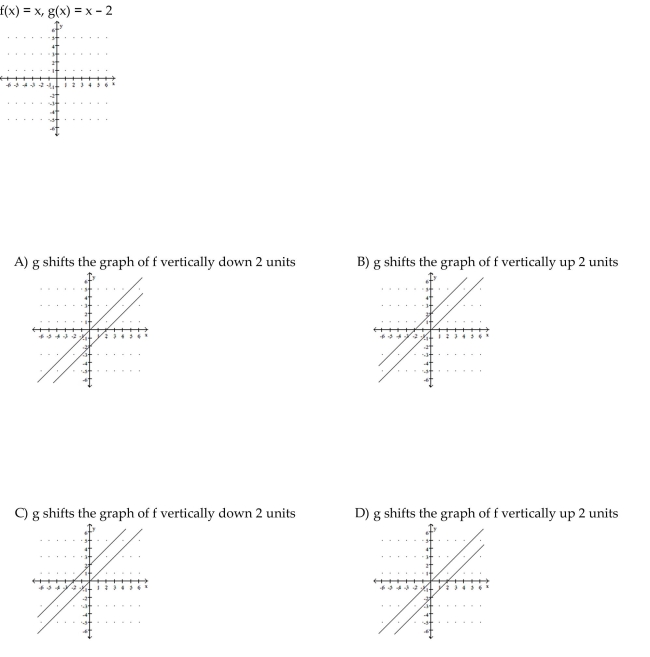
of f.


Unlock Deck
Unlock for access to all 144 flashcards in this deck.
Unlock Deck
k this deck
45
Use the vertical line test to determine whether or not the graph is a graph in which y is a function of x.
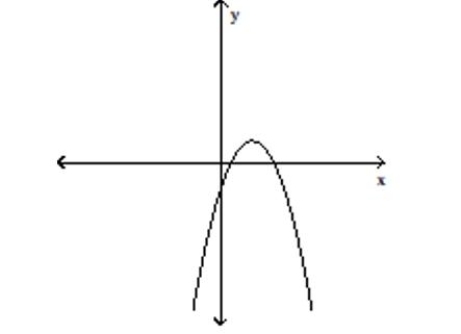
A)not a function
B)function

A)not a function
B)function

Unlock Deck
Unlock for access to all 144 flashcards in this deck.
Unlock Deck
k this deck
46
Use the vertical line test to determine whether or not the graph is a graph in which y is a function of x.

A)function
B)not a function

A)function
B)not a function

Unlock Deck
Unlock for access to all 144 flashcards in this deck.
Unlock Deck
k this deck
47
Graph the given functions on the same rectangular coordinate system. Describe how the graph of g is related to the graph
of f.
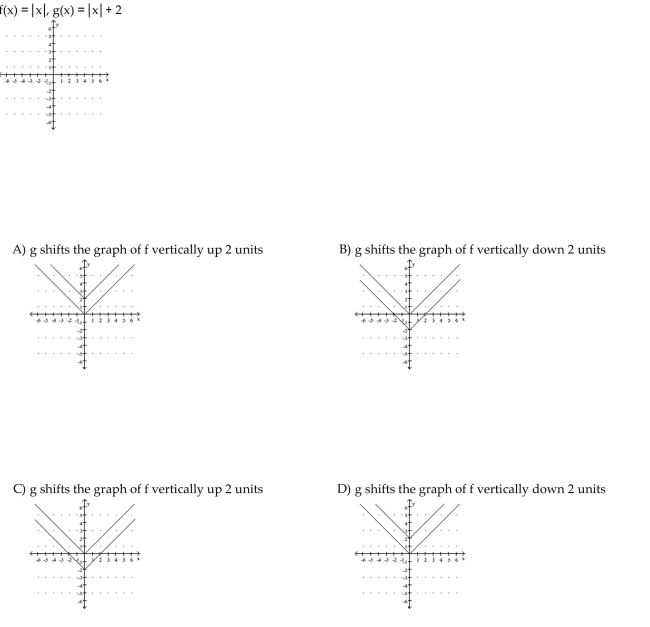
of f.


Unlock Deck
Unlock for access to all 144 flashcards in this deck.
Unlock Deck
k this deck
48
Use the vertical line test to determine whether or not the graph is a graph in which y is a function of x.
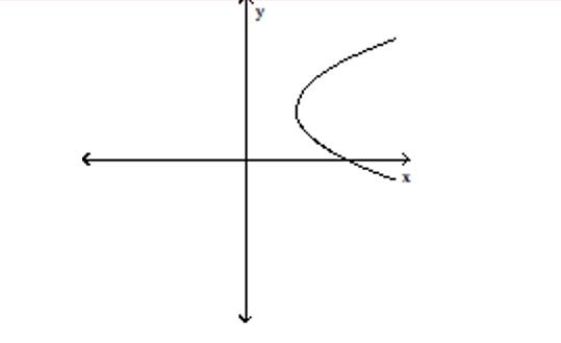
A)function
B)not a function

A)function
B)not a function

Unlock Deck
Unlock for access to all 144 flashcards in this deck.
Unlock Deck
k this deck
49
Graph the given functions on the same rectangular coordinate system. Describe how the graph of g is related to the graph
of f.
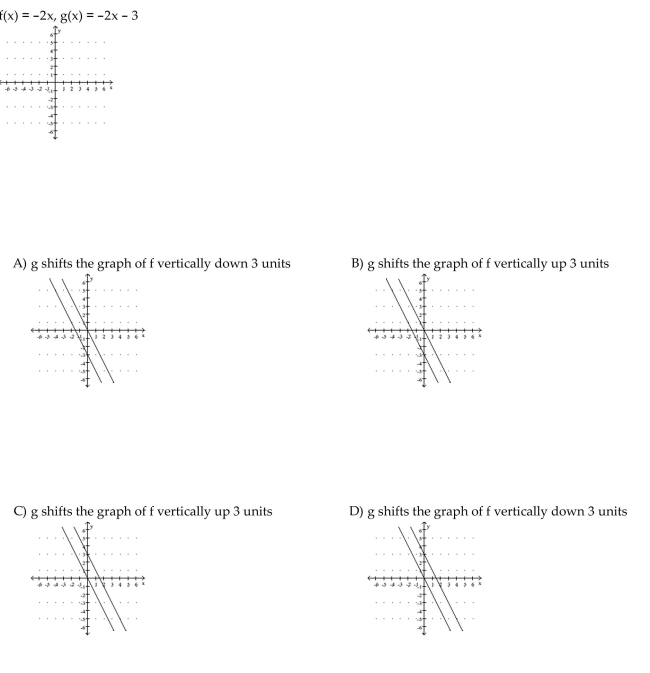
of f.


Unlock Deck
Unlock for access to all 144 flashcards in this deck.
Unlock Deck
k this deck
50
Use the vertical line test to determine whether or not the graph is a graph in which y is a function of x.
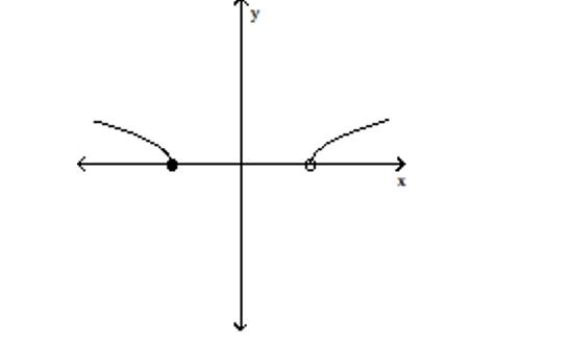
A)not a function
B)function

A)not a function
B)function

Unlock Deck
Unlock for access to all 144 flashcards in this deck.
Unlock Deck
k this deck
51
Graph the given functions on the same rectangular coordinate system. Describe how the graph of g is related to the graph
of f.
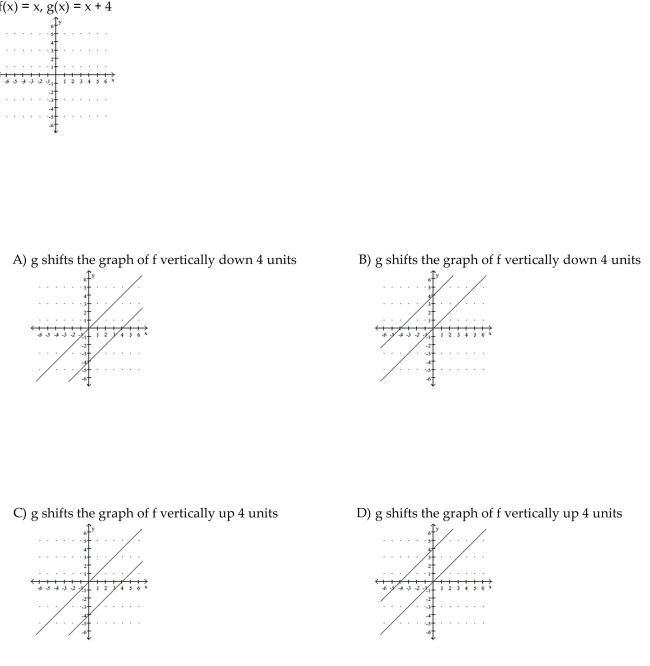
of f.


Unlock Deck
Unlock for access to all 144 flashcards in this deck.
Unlock Deck
k this deck
52
Graph the given functions on the same rectangular coordinate system. Describe how the graph of g is related to the graph
of f.

of f.


Unlock Deck
Unlock for access to all 144 flashcards in this deck.
Unlock Deck
k this deck
53
Graph the given functions on the same rectangular coordinate system. Describe how the graph of g is related to the graph
of f.
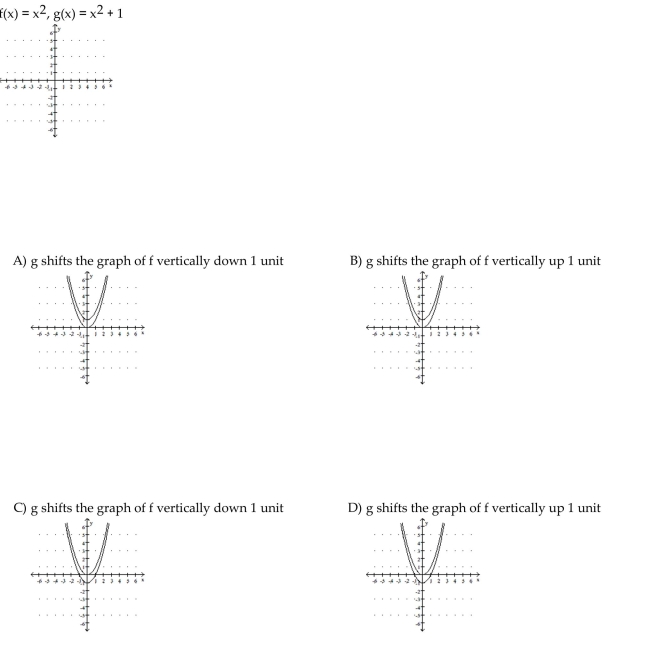
of f.


Unlock Deck
Unlock for access to all 144 flashcards in this deck.
Unlock Deck
k this deck
54
Graph the given functions on the same rectangular coordinate system. Describe how the graph of g is related to the graph
of f.
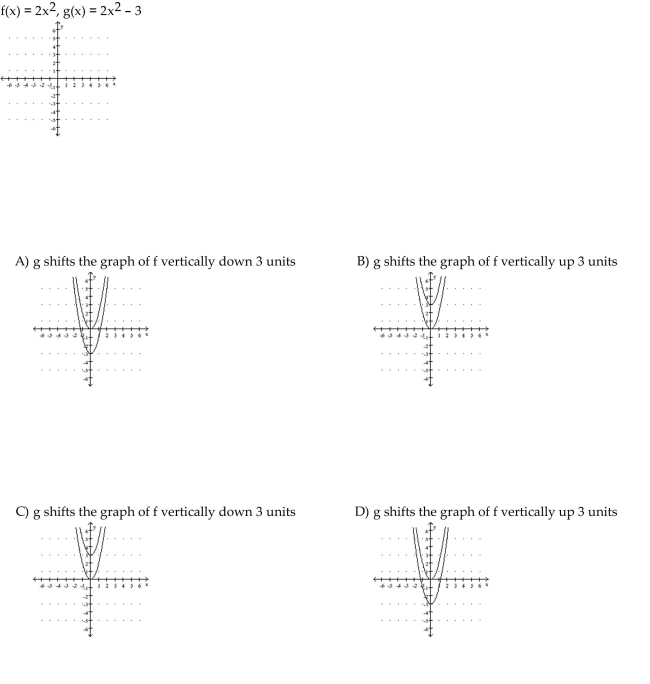
of f.


Unlock Deck
Unlock for access to all 144 flashcards in this deck.
Unlock Deck
k this deck
55
Use the vertical line test to determine whether or not the graph is a graph in which y is a function of x.
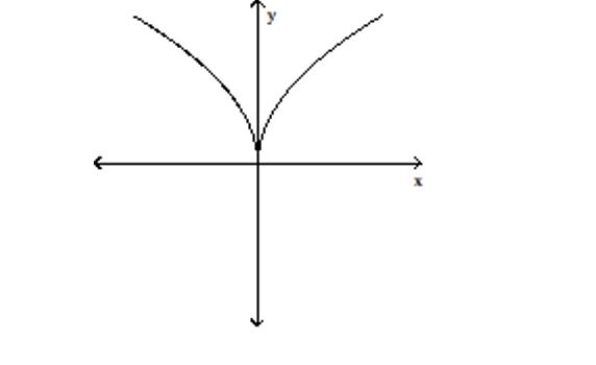
A)function
B)not a function

A)function
B)not a function

Unlock Deck
Unlock for access to all 144 flashcards in this deck.
Unlock Deck
k this deck
56
Use the vertical line test to determine whether or not the graph is a graph in which y is a function of x.

A)not a function
B)function

A)not a function
B)function

Unlock Deck
Unlock for access to all 144 flashcards in this deck.
Unlock Deck
k this deck
57
Graph the given functions on the same rectangular coordinate system. Describe how the graph of g is related to the graph
of f.
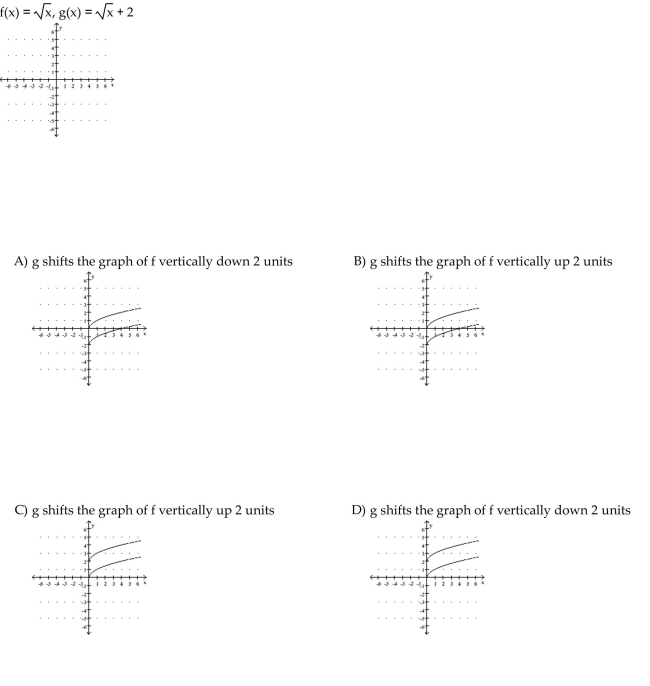
of f.


Unlock Deck
Unlock for access to all 144 flashcards in this deck.
Unlock Deck
k this deck
58
Use the vertical line test to determine whether or not the graph is a graph in which y is a function of x.

A)function
B)not a function

A)function
B)not a function

Unlock Deck
Unlock for access to all 144 flashcards in this deck.
Unlock Deck
k this deck
59
Use the vertical line test to determine whether or not the graph is a graph in which y is a function of x.
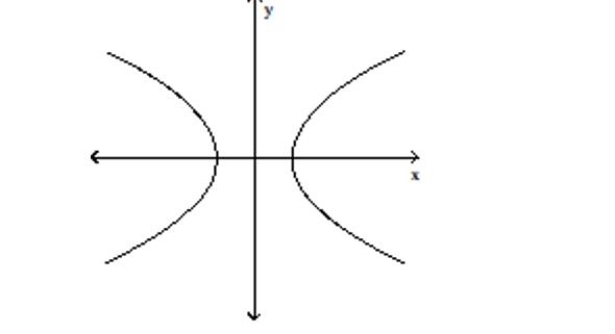
A)not a function
B)function

A)not a function
B)function

Unlock Deck
Unlock for access to all 144 flashcards in this deck.
Unlock Deck
k this deck
60
Use the vertical line test to determine whether or not the graph is a graph in which y is a function of x.
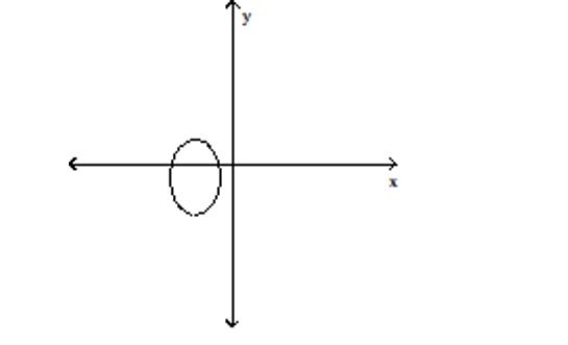
A)function
B)not a function

A)function
B)not a function

Unlock Deck
Unlock for access to all 144 flashcards in this deck.
Unlock Deck
k this deck
61
Identify the intercepts
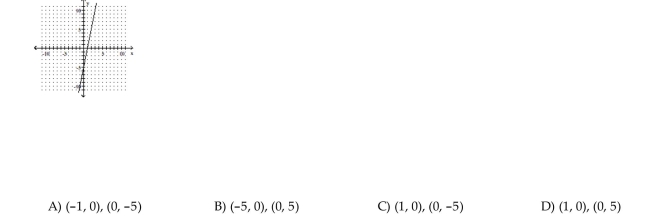


Unlock Deck
Unlock for access to all 144 flashcards in this deck.
Unlock Deck
k this deck
62
Identify the intercepts



Unlock Deck
Unlock for access to all 144 flashcards in this deck.
Unlock Deck
k this deck
63
Use the graph to find the indicated function value.
y = f(x). Find f(5)
A)-11
B)9
C)11
D)2
y = f(x). Find f(5)

A)-11
B)9
C)11
D)2

Unlock Deck
Unlock for access to all 144 flashcards in this deck.
Unlock Deck
k this deck
64
Use the graph to find the indicated function value.
y = f(x). Find f(-4)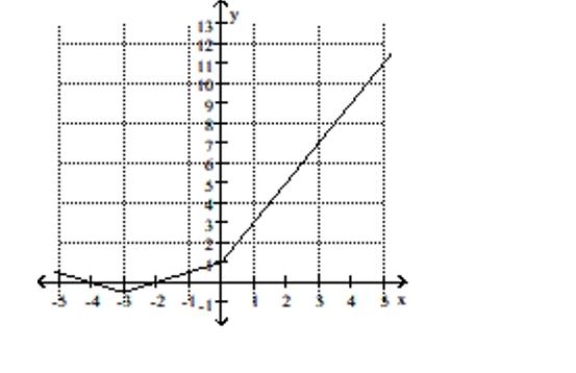
A)4
B)0
C)3
D)9
y = f(x). Find f(-4)

A)4
B)0
C)3
D)9

Unlock Deck
Unlock for access to all 144 flashcards in this deck.
Unlock Deck
k this deck
65
The graph below shows the percentage of students enrolled in the College of Engineering at State University. Use the
graph to answer the question.

Between what two years is the difference in function values equal to 5%?
A)between 1985 and 1990
B)between 1960 and 1965
C)between 1970 and 1975
D)between 1980 and 1985
graph to answer the question.

Between what two years is the difference in function values equal to 5%?
A)between 1985 and 1990
B)between 1960 and 1965
C)between 1970 and 1975
D)between 1980 and 1985

Unlock Deck
Unlock for access to all 144 flashcards in this deck.
Unlock Deck
k this deck
66
Use the graph to find the indicated function value.
y = f(x). Find f(-3)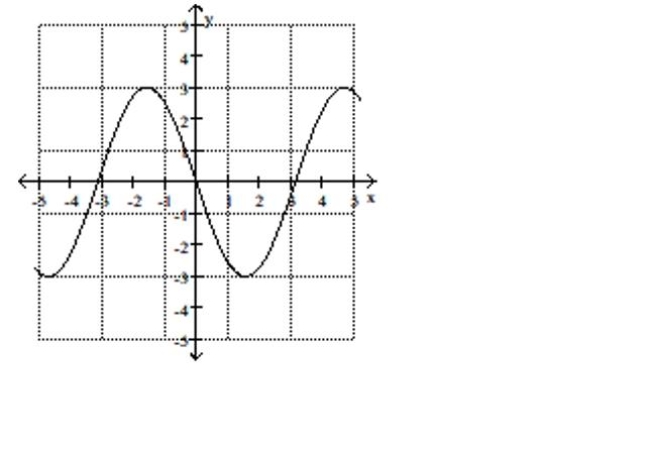
A)0.4
B)-1.6
C)-0.4
D)1.6
y = f(x). Find f(-3)

A)0.4
B)-1.6
C)-0.4
D)1.6

Unlock Deck
Unlock for access to all 144 flashcards in this deck.
Unlock Deck
k this deck
67
Use the graph to determine the function's domain and range.
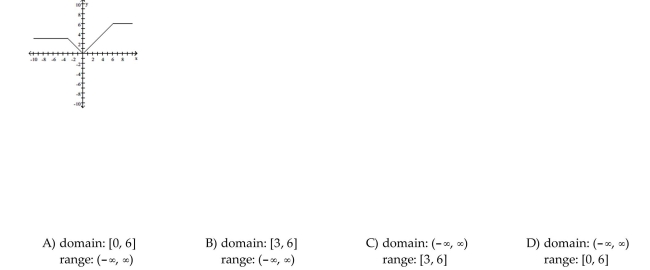


Unlock Deck
Unlock for access to all 144 flashcards in this deck.
Unlock Deck
k this deck
68
The graph below shows the percentage of students enrolled in the College of Engineering at State University. Use the
graph to answer the question.

If f(x)= 15%, what year is represented by x?
A)1975
B)1970
C)1985
D)1980
graph to answer the question.

If f(x)= 15%, what year is represented by x?
A)1975
B)1970
C)1985
D)1980

Unlock Deck
Unlock for access to all 144 flashcards in this deck.
Unlock Deck
k this deck
69
Use the graph to determine the function's domain and range.
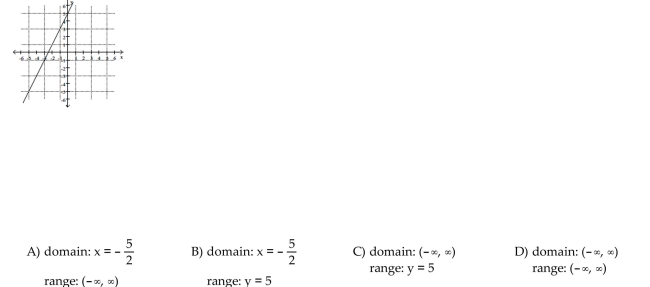


Unlock Deck
Unlock for access to all 144 flashcards in this deck.
Unlock Deck
k this deck
70
Use the graph to determine the function's domain and range.



Unlock Deck
Unlock for access to all 144 flashcards in this deck.
Unlock Deck
k this deck
71
Identify the intercepts



Unlock Deck
Unlock for access to all 144 flashcards in this deck.
Unlock Deck
k this deck
72
Identify the intercepts
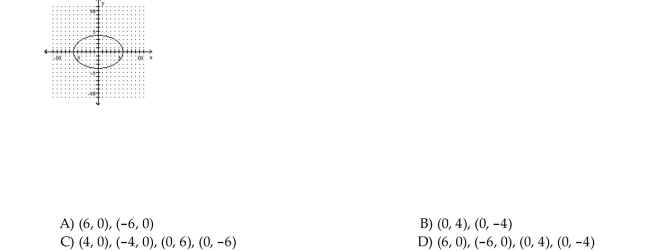


Unlock Deck
Unlock for access to all 144 flashcards in this deck.
Unlock Deck
k this deck
73
The graph below shows the percentage of students enrolled in the College of Engineering at State University. Use the
graph to answer the question.

If f represents the function, find f(1990).
A)approximately 22.5%
B)approximately 28%
C)approximately 21%
D)approximately 26%
graph to answer the question.

If f represents the function, find f(1990).
A)approximately 22.5%
B)approximately 28%
C)approximately 21%
D)approximately 26%

Unlock Deck
Unlock for access to all 144 flashcards in this deck.
Unlock Deck
k this deck
74
The graph below shows the percentage of students enrolled in the College of Engineering at State University. Use the
graph to answer the question.

Does the graph represent a function?
A)yes
B)no
graph to answer the question.

Does the graph represent a function?
A)yes
B)no

Unlock Deck
Unlock for access to all 144 flashcards in this deck.
Unlock Deck
k this deck
75
Use the graph to find the indicated function value.
y = f(x). Find f(-5)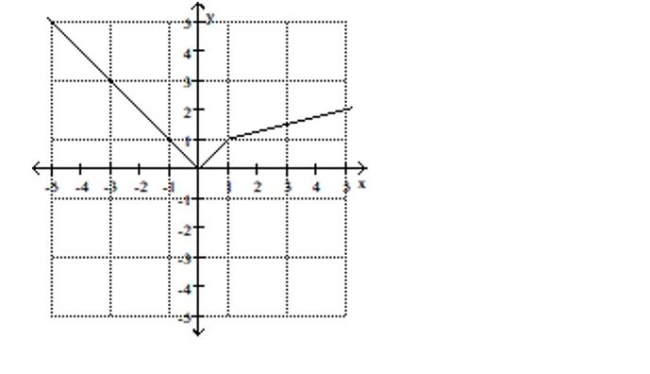
A)2
B)-5
C)5
D)17
y = f(x). Find f(-5)

A)2
B)-5
C)5
D)17

Unlock Deck
Unlock for access to all 144 flashcards in this deck.
Unlock Deck
k this deck
76
Use the graph to determine the function's domain and range.
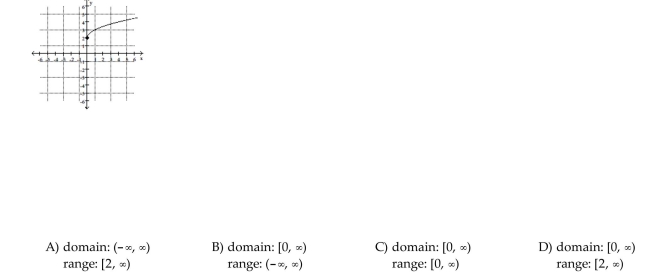


Unlock Deck
Unlock for access to all 144 flashcards in this deck.
Unlock Deck
k this deck
77
Identify the intercepts



Unlock Deck
Unlock for access to all 144 flashcards in this deck.
Unlock Deck
k this deck
78
Use the graph to find the indicated function value.
y = f(x). Find f(3).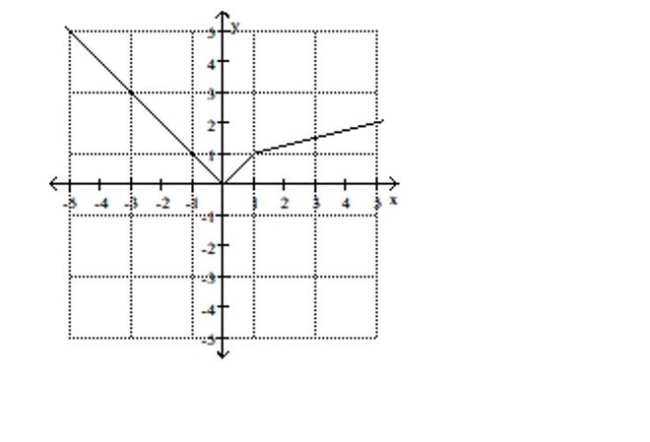
A)1.5
B)-3
C)9
D)3
y = f(x). Find f(3).

A)1.5
B)-3
C)9
D)3

Unlock Deck
Unlock for access to all 144 flashcards in this deck.
Unlock Deck
k this deck
79
Use the vertical line test to determine whether or not the graph is a graph in which y is a function of x.
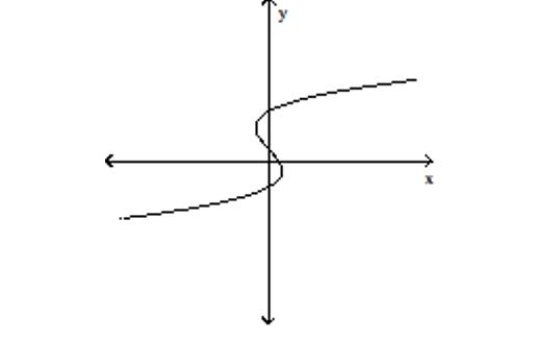
A)function
B)not a function

A)function
B)not a function

Unlock Deck
Unlock for access to all 144 flashcards in this deck.
Unlock Deck
k this deck
80
Use the graph to determine the function's domain and range.
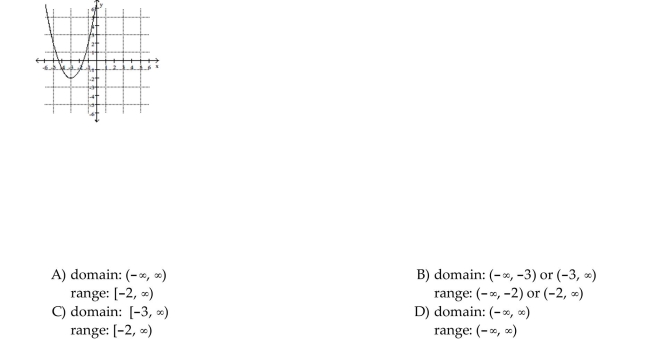


Unlock Deck
Unlock for access to all 144 flashcards in this deck.
Unlock Deck
k this deck



